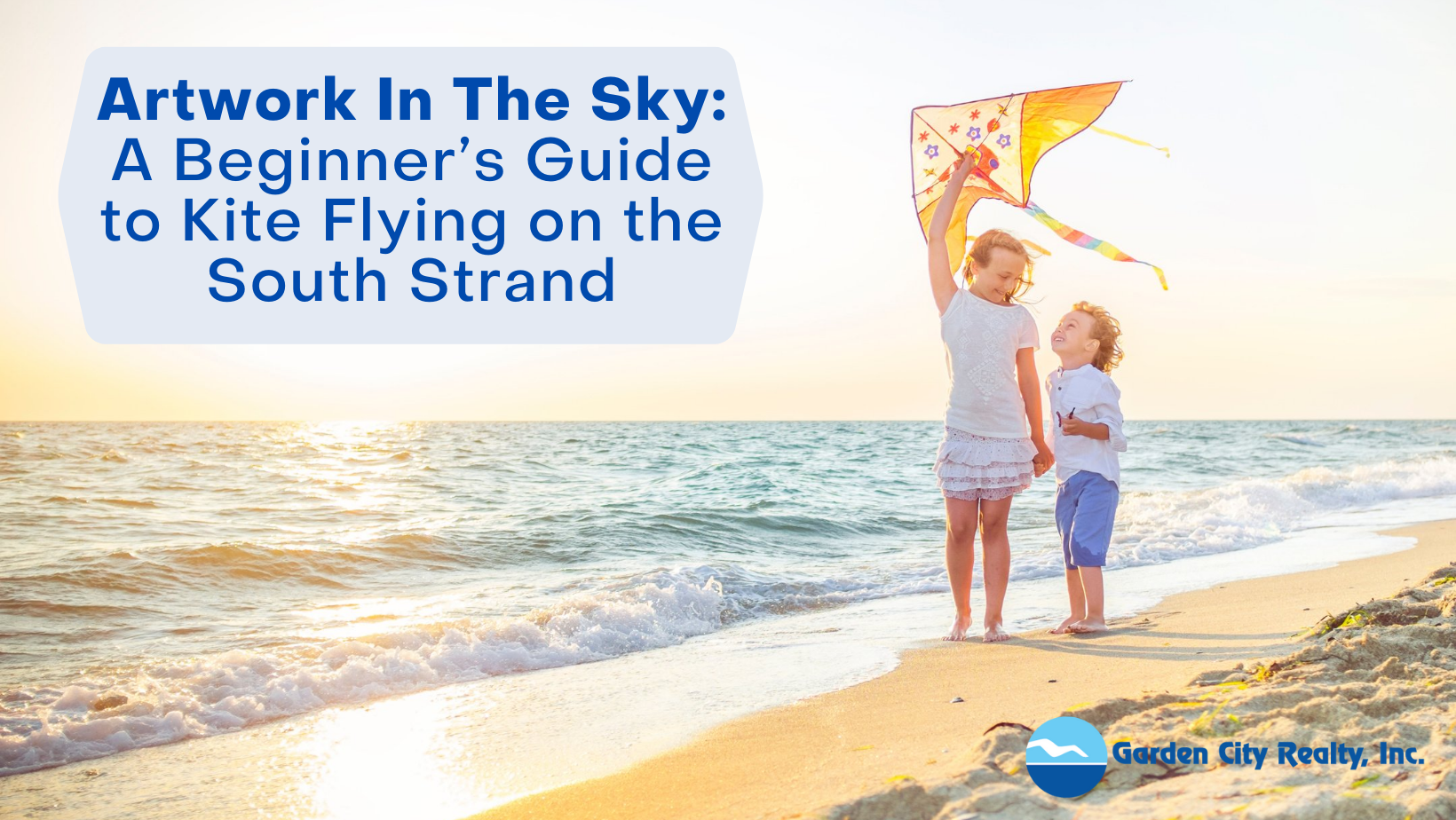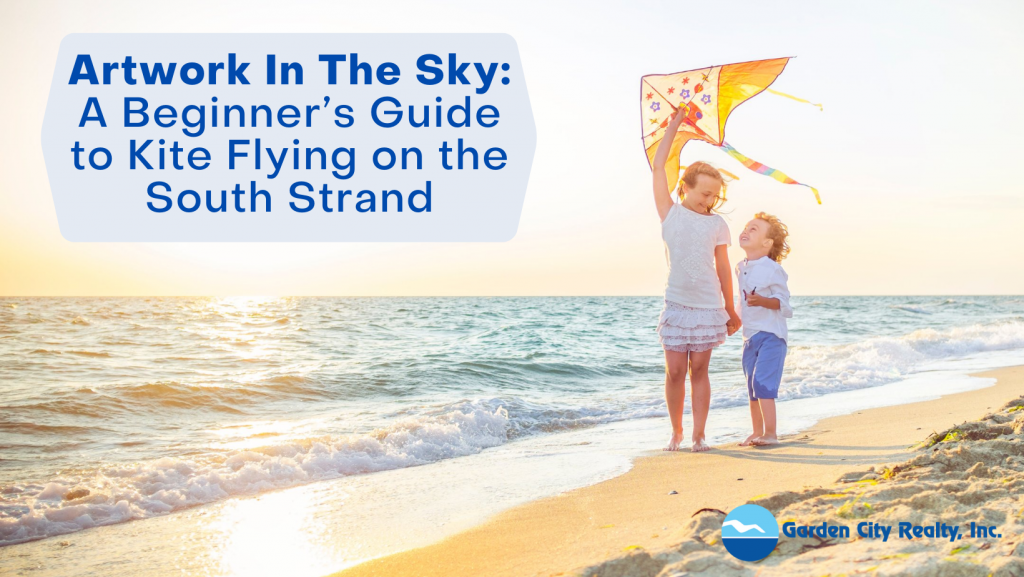Posts
ARTWORK IN THE SKY: A BEGINNER’S GUIDE TO KITE FLYING ON THE SOUTH STRAND


Hey, go fly a kite!
No, seriously, today (Jan. 14) is International Kite Day. It’s a time to explore the wild blue yonder and celebrate the uplifting (see what we did there?) experience of kite-flying, and the observance also has a deeper meaning and origin…but we’ll get to that.
If you’ve never flown a kite before, or simply need a refresher, and you’re looking for a fun and inexpensive activity to enjoy on the South Strand while you’re staying at one of Garden City Realty’s vacation rental properties, this blog entry is for you.
“Kites can be a hobby, sport, art, science project, or social event – sometimes all at the same time. Kites are fun to fly and beautiful to watch. Kite flying is a great activity for children of all ages. There is a real sense of freedom transcending borders when you fly. Flying kites crosses cultures, generations, age groups, social groups, and nations,” reads an excerpt from the American Kiteflying Association’s website.
For insights on kite flying, gear, tips, and how to get started on your South Strand airborne adventure, we tapped the expertise of local kite enthusiast/entrepreneur Richard Kligman, co-owner of long-running specialty stores Klig’s Kites.
First things first: the beaches of the South Strand, from the southern edge of Myrtle Beach through Surfside Beach, Garden City Beach and down to Murrells Inlet and Litchfield where your Garden City Beach vacation rentals are located, are excellent spots for kite flying with wide open spaces, generally mild winter weather and plenty of kite fuel (wind).
“Because that section of beaches is less populated than Myrtle Beach, if you can find a place to park, you can’t go wrong. It’s actually better than Myrtle Beach and North Myrtle Beach (for kite flying) because you don’t have as many high-rises and all that. It’s ideal.” said Kligman.
Of course, any open space will do, but flying a kite on the beach is a distinctive experience – and one you may not be able to take advantage of back home if you don’t live on the coast. So carpe fly’em!
THE GEAR
As with any hobby, sport, art, science project or social event, you CAN go all-out, over-the-top with your choice of kite.
Kites come in all shapes and sizes, can get quite elaborate and complicated, and can cost thousands of dollars.
But it is not necessary to drop a fortune, as you can get started with a $20 kite and five hundred feet of string.
“It’s a great recreational thing to do at the beach – you don’t need a lot of equipment – you need your kite and your kite string, and that’s it,” said Kligman. “Some people want the Range Rovers and the Cadillacs, and we have them. But not everybody does – and we know that. We have a kite that I’m literally staring at right now that’s 20-feet across – it’s a $600 kite. You go into a bicycle shop, and they’ll show you that English racing bike that’s like $1,500. We know you’re not going to buy it, but here it is. We sell more of these 20-foot kites than you’d think, though. A specialty store needs to have specialty, but that’s not how we’re making our money.”
What if you’re a first-timer, or a first-in-a-long-timer, what kind of kite is best suited for beginners?
“The trick is to go with something that requires little or no skill,” said Kligman. “I’m not going to sell you a $100 kite that your kid is bored with because you take over the project. The kid gets a sense of satisfaction when they can do it.”
He suggests what’s known as a delta kite – the triangular shape that’s quite common and simply designed.
“They tend to be incredibly easy to fly,” said Kligman. “You’ve seen this design from forever, ever and ever. Especially if you just want to fly a kite, I don’t want a rocket science kite, I just want something I can go out and fly without a hassle, I can put it together easily on the beach – that’s your kite.”
Single line kites, as opposed those controlled by multiple lines of string, are preferred for easier handling.
What else is essential?
“We offer an all-in package: the kite, the string and some basic instruction,” said Kligman. “There’s no need for all the bells and whistles. People come in the store and say, ‘I just want to buy a kite and go out with my kid and have some fun.’ For basically $20, you can get a parachute nylon kite – which is a heavy nylon kite – a fiberglass frame and string, everything you need – $20, you’re out the door.”
KITE-EATING OCEAN
While Charlie Brown battled the notorious Kite-Eating Tree and came out on the losing end, you may be tempting fate by taking on another of Mother Nature’s offspring too. It might seem like a cool idea to fly your kite out over the waters of the Atlantic Ocean, but Kligman recommends not trying it.
The wind on the beach can be deceptive, and many novices unwittingly end up flying their kites over The Pond.
“They won’t feel a strong breeze and their kites will be out flying over the ocean,” Kligman said. “You never want to do that, because no matter what, when you fly your kites over the ocean during spring and summer, heat rises, the gulf stream starts to kick in and the next thing you know, you’ve got your kite a couple hundred feet over the ocean and you’re frantically trying to pull that thing in, and it’s going to end up in the surf.”
Be aware of your surroundings when you launch and respect other people that are also taking advantage of the relaxation and recreation on the beach. Find a big, open space for your liftoff where you’ll have room to maneuver and not annoy your fellow South Strand beachgoers.
Also, steer clear of roads, powerlines, and here’s a big one: don’t fly kites especially high near Myrtle Beach International Airport.
There’s no need for you to rediscover electricity ala Benjamin Franklin, so flying a kite in stormy weather, especially a lightning storm, is also a bad idea.
Speaking of weather, the success of your kite flight depends largely on climate conditions – namely wind.
Early birds won’t get the worm when it comes to beach kite flying along the South Strand.
“In the mornings, the winds are fairly faint,” said Kligman. “By around noon to 1 o’clock they start to kick in.”
So, he likes to get to the beach around lunchtime and set up for an afternoon of kite flying. Generally, the best time for flying, according to Kligman, is between 1-6 p.m.
According to the American Kiteflying Association, “the right day is a day when the wind is blowing, but not too hard and not too light. Ideal flying conditions are when the wind is blowing from 8 to 15 miles per hour…Steady winds are the best for kite flying. Gusty winds can be a real challenge. Winds are often smoother and stronger farther off the ground.”
KITE RESOURCES
Even if you don’t purchase a kite at Klig’s, which has stores at Broadway at the Beach in Myrtle Beach and in North Myrtle Beach, the staff is happy to help with any problems you might have with your rig – or if you need some instruction.
Fortunately, a wealth of instruction aid is also available online.
Here are some online resources:
https://www.kite.org/about-kites/how-to-fly-a-kite/
https://www.kite.org/wp-content/uploads/2020/11/howtoflyakite-revised.pdf
https://www.wikihow.com/Fly-a-Kite
Videos:
Books:
“The Complete Book of Kites and Kite Flying”
“Kites for Everyone: How to Make and Fly Them”
“The Kite Book: All the Techniques and Know-how You Need to Fly a Kite”
CELEBRATIONS
It’s gotten to the point where celebratory days such as National Step in the Puddle and Splash Your Friend Day (Jan. 11) and National Absurdity Day (Nov. 20) are well, absurd, but there’s nothing kitschy about International Kite Day, which has an interesting history. It originated in the Indian state of Gujarat, which is famous for hosting several festivals year-round. But International Kite Day also coincides with Gujarat’s huge International Kite Festival (Jan. 14-15). It marks the transition from winter to summer on the Hindu calendar.
Besides International Kite Day, in the United States, National Kite-Flying Day is on the near horizon. Set for Feb. 8, National Kite-Flying Day is similar in spirit with International Kite Day and is dedicated to kite flying and kite making.
Closer to home, Kligman says Klig’s Kites has been tapped to help Huntington Beach State Park, located on the South Strand, launch its own kite festival that is set to debut in March.
For Kligman and other kite enthusiasts every day sailing their decorative vessels into the vast open skies is a cause for celebration.
“Watching that thing that weighs 15-20 pounds lift off and climb in the sky…I’m not a painter, I’m not an artist but that’s the closest I can come because I can paint in the sky,” he said. “I find it incredibly relaxing.”
Written by Kent Kimes for Garden City Realty
Posted on 01/13/2022 in Uncategorized # Beach Vacation, garden city beach, Murrells Inlet, south carolina, Surfside Beach, Traveling with Kids, Vacation Rental





